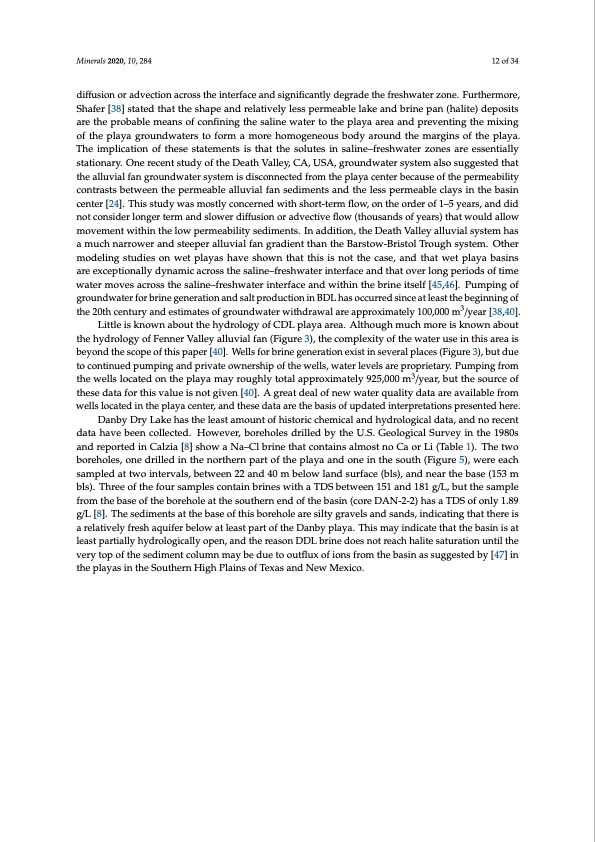
PDF Publication Title:
Text from PDF Page: 012
Minerals 2020, 10, 284 12 of 34 diffusion or advection across the interface and significantly degrade the freshwater zone. Furthermore, Shafer [38] stated that the shape and relatively less permeable lake and brine pan (halite) deposits are the probable means of confining the saline water to the playa area and preventing the mixing of the playa groundwaters to form a more homogeneous body around the margins of the playa. The implication of these statements is that the solutes in saline–freshwater zones are essentially stationary. One recent study of the Death Valley, CA, USA, groundwater system also suggested that the alluvial fan groundwater system is disconnected from the playa center because of the permeability contrasts between the permeable alluvial fan sediments and the less permeable clays in the basin center [24]. This study was mostly concerned with short-term flow, on the order of 1–5 years, and did not consider longer term and slower diffusion or advective flow (thousands of years) that would allow movement within the low permeability sediments. In addition, the Death Valley alluvial system has a much narrower and steeper alluvial fan gradient than the Barstow-Bristol Trough system. Other modeling studies on wet playas have shown that this is not the case, and that wet playa basins are exceptionally dynamic across the saline–freshwater interface and that over long periods of time water moves across the saline–freshwater interface and within the brine itself [45,46]. Pumping of groundwater for brine generation and salt production in BDL has occurred since at least the beginning of the 20th century and estimates of groundwater withdrawal are approximately 100,000 m3/year [38,40]. Little is known about the hydrology of CDL playa area. Although much more is known about the hydrology of Fenner Valley alluvial fan (Figure 3), the complexity of the water use in this area is beyond the scope of this paper [40]. Wells for brine generation exist in several places (Figure 3), but due to continued pumping and private ownership of the wells, water levels are proprietary. Pumping from the wells located on the playa may roughly total approximately 925,000 m3/year, but the source of these data for this value is not given [40]. A great deal of new water quality data are available from wells located in the playa center, and these data are the basis of updated interpretations presented here. Danby Dry Lake has the least amount of historic chemical and hydrological data, and no recent data have been collected. However, boreholes drilled by the U.S. Geological Survey in the 1980s and reported in Calzia [8] show a Na–Cl brine that contains almost no Ca or Li (Table 1). The two boreholes, one drilled in the northern part of the playa and one in the south (Figure 5), were each sampled at two intervals, between 22 and 40 m below land surface (bls), and near the base (153 m bls). Three of the four samples contain brines with a TDS between 151 and 181 g/L, but the sample from the base of the borehole at the southern end of the basin (core DAN-2-2) has a TDS of only 1.89 g/L [8]. The sediments at the base of this borehole are silty gravels and sands, indicating that there is a relatively fresh aquifer below at least part of the Danby playa. This may indicate that the basin is at least partially hydrologically open, and the reason DDL brine does not reach halite saturation until the very top of the sediment column may be due to outflux of ions from the basin as suggested by [47] in the playas in the Southern High Plains of Texas and New Mexico.PDF Image | Bristol Dry Lake Brine Compared to Brines from Cadiz

PDF Search Title:
Bristol Dry Lake Brine Compared to Brines from CadizOriginal File Name Searched:
minerals-10-00284-v2.pdfDIY PDF Search: Google It | Yahoo | Bing
Product and Development Focus for Infinity Turbine
ORC Waste Heat Turbine and ORC System Build Plans: All turbine plans are $10,000 each. This allows you to build a system and then consider licensing for production after you have completed and tested a unit.Redox Flow Battery Technology: With the advent of the new USA tax credits for producing and selling batteries ($35/kW) we are focussing on a simple flow battery using shipping containers as the modular electrolyte storage units with tax credits up to $140,000 per system. Our main focus is on the salt battery. This battery can be used for both thermal and electrical storage applications. We call it the Cogeneration Battery or Cogen Battery. One project is converting salt (brine) based water conditioners to simultaneously produce power. In addition, there are many opportunities to extract Lithium from brine (salt lakes, groundwater, and producer water).Salt water or brine are huge sources for lithium. Most of the worlds lithium is acquired from a brine source. It's even in seawater in a low concentration. Brine is also a byproduct of huge powerplants, which can now use that as an electrolyte and a huge flow battery (which allows storage at the source).We welcome any business and equipment inquiries, as well as licensing our turbines for manufacturing.| CONTACT TEL: 608-238-6001 Email: greg@infinityturbine.com | RSS | AMP |